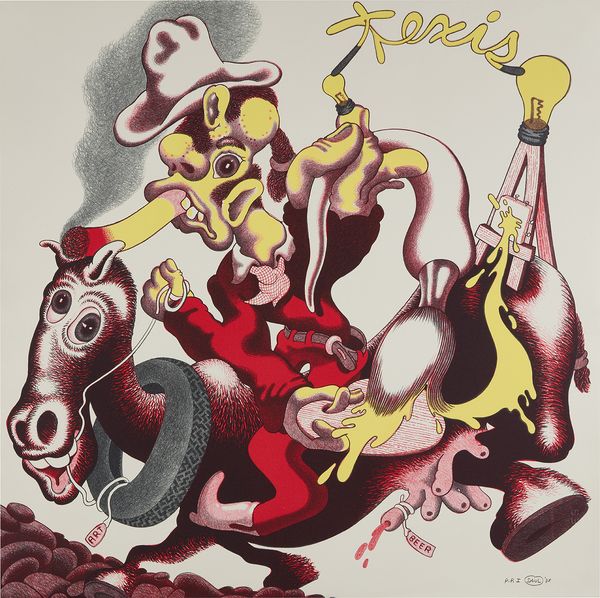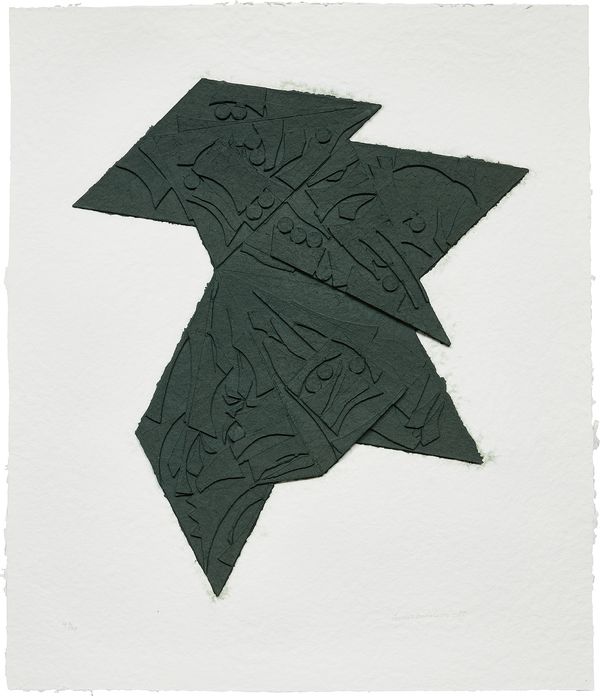Peter Saul Texis, 1985. Estimate: $800-1,200.
Editions Contemporary: Online Auction, 17-24 June.
Rebecca Tooby-Desmond, Specialist, London
Meret Oppenheim Love of Polyphemus from Mirrors of the Mind, 1975. Estimate: $800-1,200.
Best known for the Surrealist fetishism of her candid and humorous multiples, Meret Oppenheim was uniquely liberated in the roles of both artist and muse. Her career ranged from posing for erotic, nude photographs (most famously those taken by Man Ray at a printing press) to creating brilliant and controversial artworks in her own right.
Among these is Polyphemus in Love, from the Mirrors of the Mind portfolio, compiled by the Greek poet, Nicolas Calas. In his introduction to the portfolio, Calas demanded these artists overcome the navel-gazing of "art for art’s sake," that Prometheus had to take the place of Narcissus, stating “Fire is produced by holding a mirror to the sun.”
Oppenheim’s Polyphemus confronts the narcissist wishing to admire themselves with an uncanny face pressed against the glass; eyes crossed from the nearness, nose and tongue flattened against the plane. Whoever holds up this mirror, expecting to see their own likeness, instead becomes metamorphosed into a cyclopean alien, blowing a raspberry and no doubt giving two fingers to the narcissist within us all.
Jason Osborne, Associate Specialist and Cataloguer, New York
Helen Frankenthaler Ariel, 1996. Estimate: $2,500-3,500.
Did someone say "Handmade Paper?” Did I hear "Etching, Woodcut AND Aquatint?" The deceptively simple, seamless amalgamation of these techniques is only the beginning of what I adore about this print by Helen Frankenthaler. Notice the white of the paper coming through as part of the pallet, a technique she also employed in her paintings by letting raw canvas peek through and contribute to her compositions. The extravagant margins, which are absent from some of her more well-known prints. The absence of ink is as important as where ink remains. I am a fan of where it sits time-wise and stylistically in her printmaking career. At the time Frankenthaler worked on Ariel she had nearly 4 decades of printmaking under her artistic belt and about two decades working with the printmaker and publisher, Tyler Graphics in Mt. Kisco, NY. Visually it falls in between what is arguably an open airiness in her print works of the ’80s and looks to be pointing to the lush virtuosity of her well-known Tales of Genji (1998) series published just two years later. Indeed she would have been working on Ariel at the same time as The Tales of Genjii were coming to fruition. Fans of Frankenthaler might be familiar with her modus operandi that a work is complete when it appears "as if it happened all at once." I’d be hard-pressed to find an example of her prints which illustrates this dictum more succinctly.
Sarah Browne, Associate Specialist, New York
Louise Nevelson Six Pointed Star, 1980. Estimate: $2,500-3,500.
“As much as I feel I have struggled, I never for a moment in my whole life felt that I questioned my art”. — Louise Nevelson
I have always admired Louise Nevelson’s fearlessness and how she fully embodied her art. Nevelson’s signature style took form in drawing, collage, sculpture, printmaking and even in her day to day outfit adornments, my favorite of which are her custom jewelry creations.
Nevelson’s propensity for innovation and idea development naturally led her to explore the possibilities within a variety of printmaking mediums. Starting with etching at Atelier 17 in New York in 1953, followed by a fellowship at Tamarind Lithography Workshop in Los Angeles, gave Nevelson a solid foothold in print technique. Arguably the most interesting experiments were to come in the 1970s and 80s with her cast relief prints. To make her cast-paper multiples, Nevelson first constructed the composition in wood maquettes. A rubber mold was made from the maquettes and wet paper was pressed into the mold and left to dry. Six Pointed Star offers a spectacular example of this rich technique as well as Nevelson’s fluidity through mediums.



